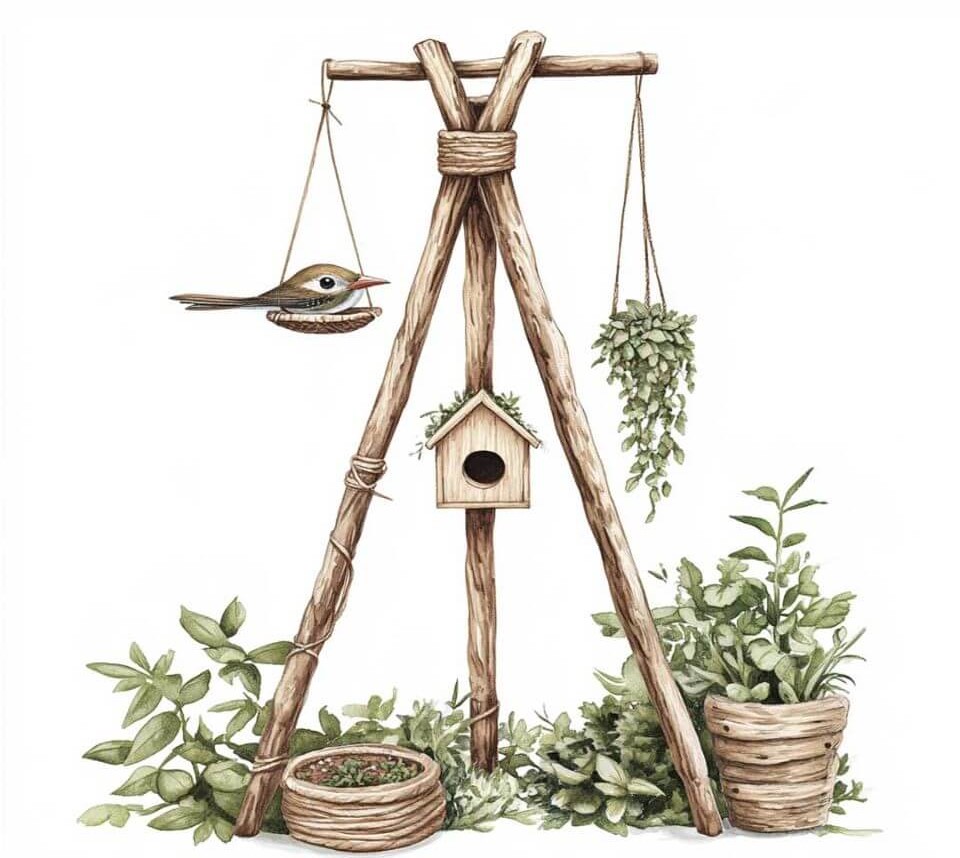Creating a habitat tripod for your garden is a fulfilling project that enhances your outdoor space while providing shelter and food for small birds. These structures are simple to construct and can be tailored to attract local bird species. By offering a safe resting spot and a consistent food source, you promote biodiversity and support the conservation of native wildlife. This guide will take you through the steps of building a habitat tripod, helping you create a functional and aesthetically pleasing addition to your garden.
Materials Needed for the Habitat Tripod
To construct a habitat tripod, gather the following materials:
- Three sturdy wooden poles (each around 6-8 feet long)
- Weather-resistant twine or rope
- A small bird feeder
- A birdhouse
- Native plants or branches for decoration
The wooden poles can be sourced from a hardware store or collected from fallen branches in your yard. Choose durable twine or rope to ensure the tripod remains stable over time. If desired, use non-toxic paint or a protective wood stain to enhance the longevity of the structure against the elements.
Step-by-Step Instructions for Building the Tripod
- Lay the three wooden poles flat on the ground, forming a triangular shape.
- Bind the top ends of the poles together with twine or rope, leaving about six inches of overlap at the top. Wrap the twine tightly around the poles multiple times and secure it with a firm knot.
- Stand the tripod upright and evenly spread the legs to create a stable base.
- Attach the bird feeder to one of the poles at a height that is accessible to birds but protected from ground predators.
- Suspend the birdhouse from the top of the tripod, positioning it to provide shelter from wind and rain.
- Decorate the tripod with native plants or branches to create additional cover and make it more inviting for birds.

Selecting the Ideal Location in Your Garden
Choose a spot in your garden that provides some protection from extreme weather, such as near a tree or hedge. Ensure the tripod is visible from a window so you can observe visiting birds. The location should be away from high-traffic areas to minimize disturbances and should offer a clear flight path for birds to approach and leave safely. Positioning the habitat near natural food sources like shrubs or flowering plants can further increase its appeal to birds.
How to Attract Small Birds to Your Habitat
Encourage small birds to visit by offering a variety of food sources, such as seeds, suet, and mealworms. Keep the bird feeder stocked and clean to maintain a reliable food supply. Plant native flowers and shrubs that produce seeds and berries to provide additional nourishment. Set up a shallow water source for drinking and bathing, ensuring it remains clean and refilled. Avoid using pesticides, as they can be harmful to birds and reduce the availability of insects that serve as natural food sources.
Benefits of Providing Shelter and Food for Birds
Supporting local bird populations by offering shelter and food brings multiple benefits. Birds help control pests by consuming insects, reducing the need for chemical pesticides. They also play a role in pollination and seed dispersal, contributing to the overall health of your garden ecosystem. Additionally, birdwatching is a relaxing and educational activity that fosters a deeper appreciation for nature.
Maintaining and Monitoring Your Bird Habitat
To ensure the effectiveness and durability of your habitat tripod, perform regular maintenance. Periodically check the structure’s stability, tightening the twine or rope if needed. Clean the bird feeder and birdhouse frequently to prevent the spread of disease. Observe the bird species visiting your garden and take note of any seasonal changes. Adjust the types of food provided to align with birds’ dietary needs throughout the year.
Conclusion: Enhancing Your Garden with a Bird-Friendly Habitat
Building a habitat tripod is an easy yet meaningful way to improve your garden while supporting local bird species. By offering food and shelter, you create a welcoming environment that benefits both the birds and your outdoor space. This project enriches your garden with natural beauty and brings the joy of birdwatching to your daily life. Take this opportunity to connect with nature and enjoy the presence of small birds in your garden for years to come.